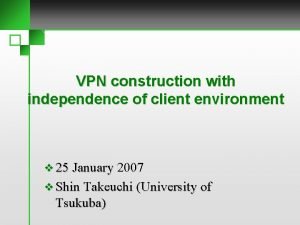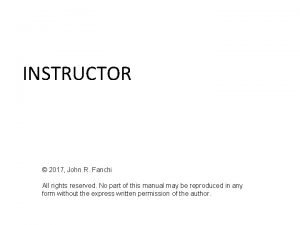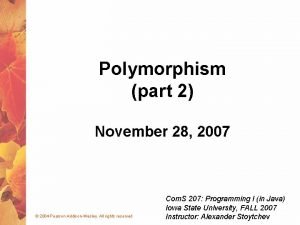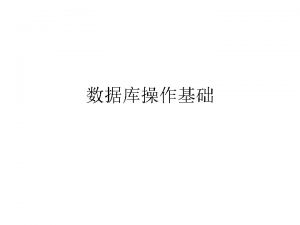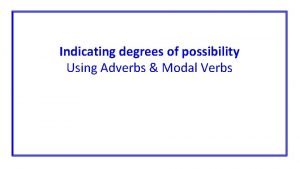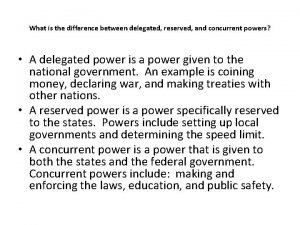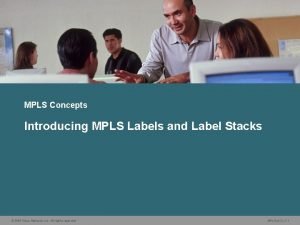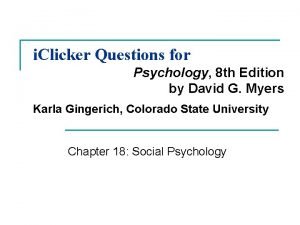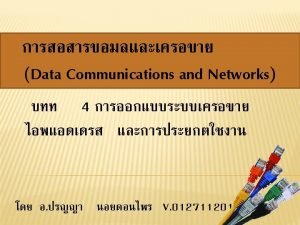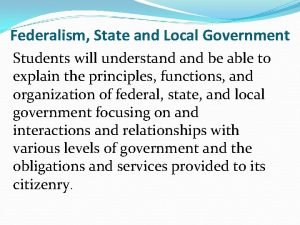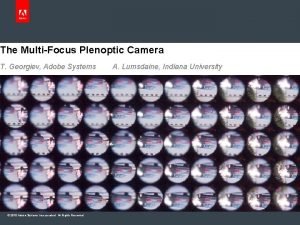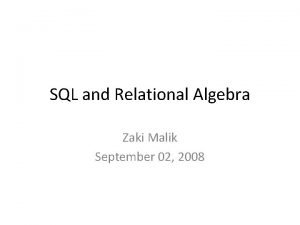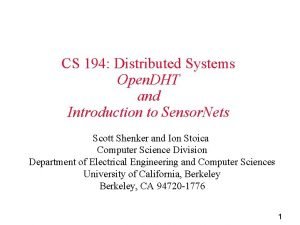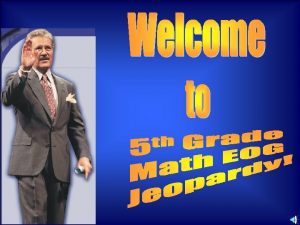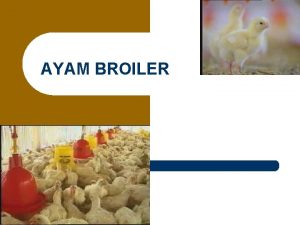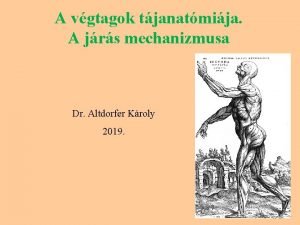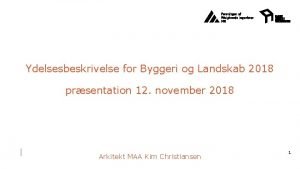C Express 5 2012 All rights reserved ress



















































































- Slides: 83

쉽게 풀어쓴 C언어 Express 제 5장 수식과 연산자 © 2012 생능출판사 All rights reserved ress p C Ex


수식의 예 © 2012 생능출판사 All rights reserved






예제 #include <stdio. h> int main() { int x, y, result; printf("두개의 정수를 입력하시오: "); scanf("%d %d", &x, &y); x y result = x + y; printf("%d + %d = %d", x, y, result); result = x - y; // 뺄셈 연산 printf("%d - %d = %d", x, y, result); result = x * y; // 곱셈 연산 printf("%d + %d = %d", x, y, result); result = x / y; // 나눗셈 연산 printf("%d / %d = %d", x, y, result); result = x % y; // 나머지 연산 printf("%d %% %d = %d", x, y, result); return 0; } © 2012 생능출판사 All rights reserved 두개의 정수를 입력하시오: 7 4 7 + 4 = 11 7 - 4 = 3 7 + 4 = 28 7 / 4 = 1 7 % 4 = 3


나눗셈 연산자 int main() { double x, y, result; printf("두개의 실수를 입력하시오: "); scanf("%lf %lf", &x, &y); result = x + y; // 덧셈 연산을 하여서 결과를 result에 대입 printf("%f / %f = %f", x, y, result); . . . result = x / y; printf("%f / %f = %f", x, y, result); return 0; } © 2012 생능출판사 All rights reserved 두개의 실수를 입력하시오: 7 4 7. 000000 + 4. 000000 = 11. 000000 7. 000000 - 4. 000000 = 3. 000000 7. 000000 + 4. 000000 = 28. 000000 7. 000000 / 4. 000000 = 1. 750000


나머지 연산자 // 나머지 연산자 프로그램 #include <stdio. h> #define SEC_PER_MINUTE 60 // 1분은 60초 int main(void) { int input, minute, second; 70 input 60 SEC_PER_ MINUTE 1 minute 10 second printf("초단위의 시간을 입력하시요: (32억초이하) "); scanf("%d", &input); // 초단위의 시간을 읽는다. minute = input / SEC_PER_MINUTE; // 몇 분 second = input % SEC_PER_MINUTE; // 몇 초 printf("%d초는 %d분 %d초입니다. n", input, minute, second); return 0; } © 2012 생능출판사 All rights reserved 초단위의 시간을 입력하시요: (32억초이하) 70 70초는 1분 10초 입니다.




예제: 증감 연산자 #include <stdio. h> int main(void) { int x=10, y=10; 10 x -x 10 y printf("x=%dn", x); printf("++x의 값=%dn", ++x); printf("x=%dnn", x); printf("y=%dn", y); printf("y++의 값=%dn", y++); printf("y=%dn", y); return 0; } © 2012 생능출판사 All rights reserved x=10 ++x의 값=11 x=11 y=10 y++의 값=10 y=11








복합 대입 연산자 // 복합 대입 연산자 프로그램 #include <stdio. h> int main(void) { int x = 10, y = 10, z = 33; x 10 11 y 10 20 z 33 2 x += 1; // x = x + 1; y *= 2; // y = y * 2; z %= x + y; // z = z % (x + y ); 주의!! printf("x = %d y = %d z = %d n", x, y, z); return 0; } © 2012 생능출판사 All rights reserved x = 11 y = 20 z = 2




올림 변환과 내림 변환 #include <stdio. h> 11. 23456 10000 16 int main(void) 11 { char c; c i int i; float f; c = 10000; // 내림 변환 i = 1. 23456 + 10; // 내림 변환 f = 10 + 20; // 올림 변환 printf("c = %d, i = %d, f = %f n", c, i, f); return 0; } 30 30. 000000 f c: . . . convert 1. c(10) : warning C 4305: '=' : 'int'에서 'char'(으)로 잘립니다. c: . . . convert 1. c(11) : warning C 4244: '=' : 'double'에서 'int'(으)로 변환하면서 데이터가 손실될 수 있습니다. c=16, i=11, f=30. 000000 © 2012 생능출판사 All rights reserved

















AND 연산자 © 2012 생능출판사 All rights reserved

OR 연산자 © 2012 생능출판사 All rights reserved






실습: 윤년 // 윤년 프로그램 #include <stdio. h> int main(void) { int year, result; printf("연도를 입력하시오: "); scanf("%d", &year); result = ((year % 4 == 0) && (year % 100 != 0)) || (year % 400 == 0); printf("result=%d ", result); return 0; } © 2012 생능출판사 All rights reserved 연도를 입력하시오: 2012 result=1




예제 첫번째 수= 2 두번째 수= 3 큰수=3 작은수=2 #include <stdio. h> int main(void) { int x, y; printf("첫번째 수="); scanf("%d", &x); printf("두번째 수="); scanf("%d", &y); printf("큰수=%d n", (x > y) ? x : y); printf("작은수=%d n", (x < y) ? x : y); } 2 > < 3 2 x © 2012 생능출판사 All rights reserved y 3



비트 AND 연산자 0 AND 0 = 0 1 AND 0 = 0 0 AND 1 = 0 1 AND 1 = 1 © 2012 생능출판사 All rights reserved

비트 OR 연산자 0 OR 0 = 0 1 OR 0 = 1 0 OR 1 = 1 1 OR 1 = 1 © 2012 생능출판사 All rights reserved

비트 XOR 연산자 0 XOR 0 = 0 1 XOR 0 = 1 0 XOR 1 = 1 1 XOR 1 = 0 © 2012 생능출판사 All rights reserved

비트 NOT 연산자 NOT 0 = 1 NOT 1 = 0 © 2012 생능출판사 All rights reserved

예제: 비트 연산자 #include <stdio. h> int main(void) { int x = 9; int y = 10; printf("비트 AND = %08 X", x & y); printf("비트 OR = %08 X", x | y); printf("비트 XOR = %08 X", x ^ y); printf("비트 NOT = %08 X", ~x ); return 0; } © 2012 생능출판사 All rights reserved // // // 1001 1010 00001000 00001011 00000011 11110110 비트 AND = 00000008 비트 OR = 0000000 B 비트 XOR = 00000003 비트 NOT = FFFFFFF 6




예제: 비트 이동 연산자 #include <stdio. h> int main(void) { int x = 4; printf("비트 << = %#08 x", x << 1); printf("비트 >> = %#08 x", x >> 1); // 0100 // 1000 // 0010 return 0; } © 2012 생능출판사 All rights reserved 비트 << = 0 x 000008 비트 >> = 0 x 000002



비트 연산 이용 color : AAAA RRRR GGGG BBBB mask : 0000 1111 0000 & ---------------------result: 0000 RRRR 0000 result : 0000 RRRR 0000 shift : >> 16 >> -------------------result: 0000 0000 RRRR © 2012 생능출판사 All rights reserved

실습 예제 #include <stdio. h> int main(void) { unsigned int color=0 x 00380000; unsigned int result; result = color & 0 x 00 ff 0000; result = result >> 16; printf("%#08 x", result); return 0; // 픽셀의 색상 // 마스크 연산 // 비트 이동 연산 } 픽셀의 색상을 16진수로 입력: 00380000 입력된 픽셀의 색상 = 0 x 380000 추출된 빨강색 = 0 x 000038 © 2012 생능출판사 All rights reserved





결합규칙의 예 © 2012 생능출판사 All rights reserved


예제 #include <stdio. h> int main(void) { int x=0, y=0; int result; result = 2 > 3 || 6 > 7; printf("%d", result); result = 2 || 3 && 3 > 2; printf("%d", result); result = x = y = 1; printf("%d", result); result = - ++x + y--; printf("%d", result); return 0; } © 2012 생능출판사 All rights reserved 0 1 1 -1


잘못된 부분은 어디에? #include <stdio. h> int main(void) { double f_temp; double c_temp; printf("화씨온도를 입력하시오"); scanf("%lf", &f_temp); c_temp = 5 / 9 * (f_temp - 32); printf("섭씨온도는 %f입니다, c_temp); return 0; } c_temp = 5. 0 / 9. 0 * (f_temp - 32); © 2012 생능출판사 All rights reserved 화씨온도를 입력하시오: 90 섭씨온도는 0. 000000입니다.


Q&A © 2012 생능출판사 All rights reserved
 Specification by example
Specification by example Copyright 2015 all rights reserved
Copyright 2015 all rights reserved All rights reserved sentence
All rights reserved sentence Creative commons vs all rights reserved
Creative commons vs all rights reserved Confidential all rights reserved
Confidential all rights reserved Sentinel-controlled loop pseudocode
Sentinel-controlled loop pseudocode Copyright 2015 all rights reserved
Copyright 2015 all rights reserved 2012 pearson education inc
2012 pearson education inc Microsoft corporation. all rights reserved.
Microsoft corporation. all rights reserved. Microsoft corporation. all rights reserved
Microsoft corporation. all rights reserved Microsoft corporation. all rights reserved
Microsoft corporation. all rights reserved Pearson education inc. all rights reserved
Pearson education inc. all rights reserved Dell all rights reserved copyright 2009
Dell all rights reserved copyright 2009 Warning all rights reserved
Warning all rights reserved C all rights reserved
C all rights reserved All rights reserved formula
All rights reserved formula Warning all rights reserved
Warning all rights reserved Confidential all rights reserved
Confidential all rights reserved Microsoft corporation. all rights reserved
Microsoft corporation. all rights reserved Pearson education inc. all rights reserved
Pearson education inc. all rights reserved Copyright © 2018 all rights reserved
Copyright © 2018 all rights reserved 2017 all rights reserved
2017 all rights reserved Copyright 2010 pearson education inc
Copyright 2010 pearson education inc 2010 pearson education inc
2010 pearson education inc Confidential all rights reserved
Confidential all rights reserved Confidential all rights reserved
Confidential all rights reserved Ress
Ress 쉽게 풀어쓴 c언어 express 12장
쉽게 풀어쓴 c언어 express 12장 Ress vpn
Ress vpn Ress 파일
Ress 파일 R rights reserved
R rights reserved Rights reserved
Rights reserved Sql server 2005 express management studio
Sql server 2005 express management studio Sql server 2012 express
Sql server 2012 express Positive rights and negative rights
Positive rights and negative rights Littorial rights
Littorial rights Conclusion of rights
Conclusion of rights Legal rights and moral rights
Legal rights and moral rights Negative rights
Negative rights Positive vs negative rights
Positive vs negative rights Negative right
Negative right Negative right
Negative right Name all the lines
Name all the lines Modal verbs degrees of possibility
Modal verbs degrees of possibility What are delegated reserved and concurrent powers
What are delegated reserved and concurrent powers Reserved powers.
Reserved powers. Peachres
Peachres Mpls label operations
Mpls label operations Bart complied with his friends
Bart complied with his friends Sql sailors tables
Sql sailors tables Reserved ip addresses
Reserved ip addresses Reserved powers pictures
Reserved powers pictures National powers
National powers In a banyan switch micro switch
In a banyan switch micro switch Space reserved
Space reserved Find the colors of boats reserved by lubber
Find the colors of boats reserved by lubber Reserved mark
Reserved mark Infusion in pharmaceutics
Infusion in pharmaceutics Space reserved
Space reserved Reserved power
Reserved power Reserved
Reserved Reserved material
Reserved material Reserved mark
Reserved mark Reserved mark
Reserved mark Reserved mark
Reserved mark Reserved mark
Reserved mark Reserved mark
Reserved mark Reserved mark
Reserved mark Reserved mark
Reserved mark Reserved mark
Reserved mark Love all serve all
Love all serve all Interventi sociali rivolti alla persona
Interventi sociali rivolti alla persona Powers above
Powers above I work all night
I work all night Basic communication operations in parallel computing
Basic communication operations in parallel computing Sistem all in all out
Sistem all in all out V. cubiti mediana
V. cubiti mediana Silent night holy night all is calm
Silent night holy night all is calm 馮定華
馮定華 All of you is more than enough for all of me
All of you is more than enough for all of me John donne born
John donne born Till he returns or calls me home
Till he returns or calls me home Above all powers
Above all powers Ydelsesbeskrivelse 2018
Ydelsesbeskrivelse 2018




























